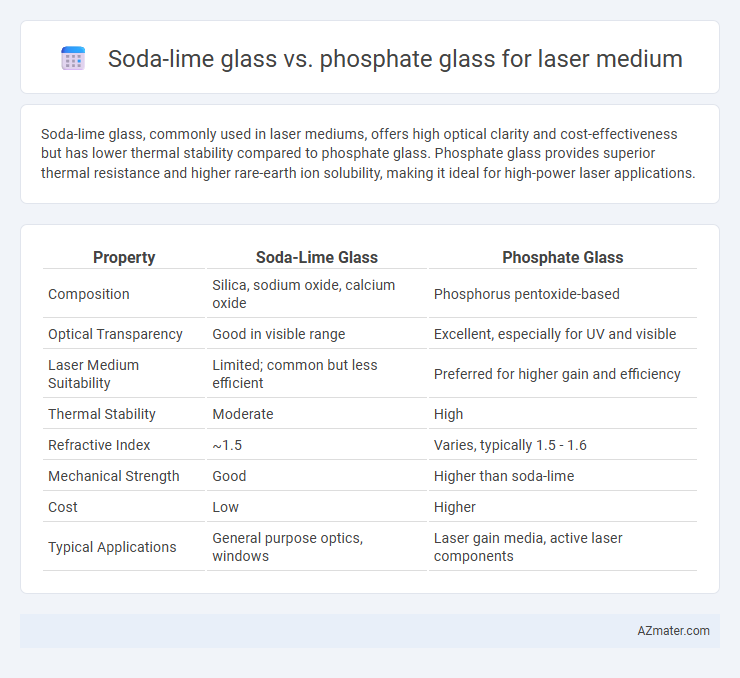Soda-lime glass, commonly used in laser mediums, offers high optical clarity and cost-effectiveness but has lower thermal stability compared to phosphate glass. Phosphate glass provides superior thermal resistance and higher rare-earth ion solubility, making it ideal for high-power laser applications.
Table of Comparison
| Property | Soda-Lime Glass | Phosphate Glass |
|---|---|---|
| Composition | Silica, sodium oxide, calcium oxide | Phosphorus pentoxide-based |
| Optical Transparency | Good in visible range | Excellent, especially for UV and visible |
| Laser Medium Suitability | Limited; common but less efficient | Preferred for higher gain and efficiency |
| Thermal Stability | Moderate | High |
| Refractive Index | ~1.5 | Varies, typically 1.5 - 1.6 |
| Mechanical Strength | Good | Higher than soda-lime |
| Cost | Low | Higher |
| Typical Applications | General purpose optics, windows | Laser gain media, active laser components |
Introduction to Laser Medium Glasses
Soda-lime glass, characterized by its high alkali content and affordability, offers moderate optical clarity but limited resistance to thermal and optical damage, making it less ideal for high-power laser mediums. Phosphate glass, with its unique composition containing phosphorus pentoxide, provides superior rare-earth ion solubility and enhanced lasing efficiency due to lower phonon energy and better thermal stability. These properties make phosphate glass the preferred laser medium for high-performance solid-state lasers requiring efficient energy transfer and minimal quenching effects.
Overview of Soda-Lime Glass Composition
Soda-lime glass primarily consists of approximately 70-75% silica (SiO2), 12-15% sodium oxide (Na2O), and 10-15% calcium oxide (CaO), with minor amounts of alumina and magnesium oxide to enhance durability and chemical stability. This composition provides good optical clarity and thermal stability, making it a cost-effective choice for many laser medium applications despite its relatively lower laser damage threshold compared to phosphate glass. The alkali and alkaline earth oxides in soda-lime glass influence its refractive index and thermal expansion, which are critical factors in laser performance and longevity.
Phosphate Glass: Structure and Properties
Phosphate glass, characterized by its unique network of P2O5 tetrahedra, offers superior laser performance compared to soda-lime glass due to its higher rare-earth ion solubility and lower phonon energy, enabling efficient lasing at various wavelengths. Its low melting temperature and favorable thermal expansion coefficient enhance the fabrication of high-quality, doped laser media with improved optical homogeneity and reduced scattering losses. The tailored composition of phosphate glass allows precise tuning of its refractive index and gain characteristics, making it an optimal choice for high-power solid-state laser applications.
Optical Properties Comparison
Soda-lime glass exhibits moderate optical transmission with higher refractive index (~1.52) and increased susceptibility to hydroxyl absorption, limiting transparency in the infrared range. Phosphate glass offers superior optical clarity, lower refractive index (~1.50), and enhanced ultraviolet to near-infrared transmission, making it more effective for laser media requiring minimal scattering and absorption losses. Additionally, phosphate glass typically provides better spectral uniformity and higher damage thresholds critical for high-power laser applications.
Thermal Stability and Durability
Phosphate glass offers superior thermal stability compared to soda-lime glass, making it more suitable for laser mediums that operate at high temperatures. Its chemical composition provides enhanced durability and resistance to thermal shock, ensuring consistent laser performance. In contrast, soda-lime glass, while more cost-effective, exhibits lower thermal stability and is prone to degradation under intense laser irradiation.
Laser Damage Threshold Analysis
Phosphate glass typically exhibits a higher laser damage threshold (LDT) compared to soda-lime glass, making it more suitable for high-power laser applications requiring durability and minimal degradation risk. Its superior LDT is attributed to its unique chemical composition, which offers better resistance to laser-induced thermal and mechanical stress. Conversely, soda-lime glass has lower LDT values and is less favored in laser media where high-intensity pulses are involved.
Doping Compatibility and Efficiency
Soda-lime glass offers limited doping compatibility due to its higher alkali content, which can cause ion migration and reduce laser efficiency. Phosphate glass provides superior doping compatibility with rare-earth ions such as neodymium and erbium, enabling higher concentrations and improved energy transfer efficiency. This results in phosphate glass being more efficient as a laser medium, supporting stronger and more stable laser emission.
Cost and Manufacturing Considerations
Soda-lime glass offers a cost-effective and widely available option for laser mediums due to its simple manufacturing process and abundant raw materials, making it suitable for large-scale production. Phosphate glass, though more expensive, provides superior optical properties and durability but requires more complex manufacturing techniques, increasing production costs and limiting its use to specialized applications. Choosing between soda-lime and phosphate glass hinges on balancing budget constraints with performance requirements in laser systems.
Common Applications in Laser Systems
Soda-lime glass is commonly used in low-power laser systems due to its cost-effectiveness and ease of fabrication, making it suitable for protective windows and simple laser housing. Phosphate glass serves as a preferred laser medium in high-power and ultrafast laser systems because of its superior thermal stability and high rare-earth ion solubility, enhancing efficiency in fiber lasers and solid-state laser amplifiers. The choice between soda-lime and phosphate glass directly impacts laser performance, with phosphate glass dominating applications requiring high gain, such as in high-energy pulsed lasers.
Selecting the Right Glass: Decision Factors
Soda-lime glass offers cost-effective production and good mechanical strength but suffers from higher optical losses and limited resistance to high-energy laser pulses compared to phosphate glass. Phosphate glass provides superior optical clarity, higher rare-earth ion solubility, and excellent thermal stability, making it ideal for high-power laser media requiring efficient energy storage. Selecting the right glass depends on factors such as laser wavelength compatibility, thermal management needs, and the required laser output power, with phosphate glass preferred for high-performance applications despite its higher cost.

Infographic: Soda-lime glass vs Phosphate glass for Laser medium
 azmater.com
azmater.com